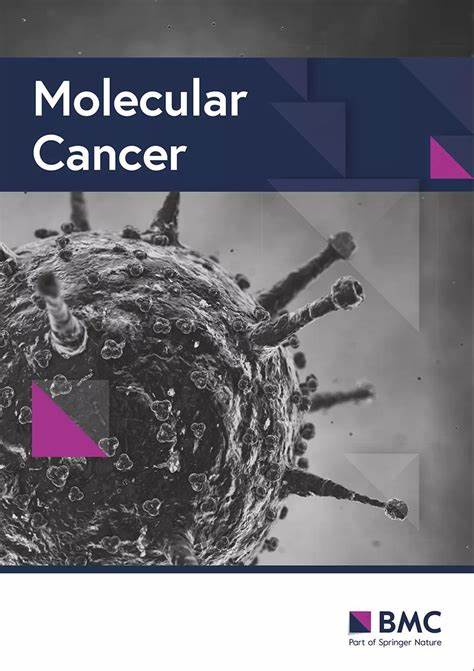CircAKT3 promotes prostate cancer proliferation and metastasis by enhancing the binding of RPS27A and RPL11
IF 27.7
1区 医学
Q1 BIOCHEMISTRY & MOLECULAR BIOLOGY
引用次数: 0
Abstract
Metastatic prostate cancer (PCa) is a leading cause of mortality among PCa patients. Although circular RNAs (circRNAs) are recognized for their pivotal roles in tumorigenesis, the specifics of their influence within the context of PCa have yet to be fully elucidated. RT-qPCR was conducted to evaluate circAKT3 expression in PCa cells and in both tumor and adjacent noncancerous tissues. The oncogenic role of circAKT3 was confirmed through a combination of in vitro and in vivo experiments. Mechanistic investigations using RNA-pulldown, RNA immunoprecipitation (RIP), fluorescence in situ hybridization (FISH), immunofluorescence (IF), and Chromatin Immunoprecipitation (ChIP) assays explored how circAKT3 modulates c-Myc activity via interactions with RPS27A and RPL11. Additionally, Western Blotting and further in vitro and in vivo studies assessed circAKT3's influence on PCa progression through MST1. This research identified the function and regulation of circAKT3, a circRNA derived from exons 2 to 8 of the kinase-b3 (AKT3) gene, in human PCa cells. CircAKT3 was significantly correlated with clinical indicators of disease severity, including D'Amico risk classification, the Gleason score, and pT stage. Both in vitro and in vivo experiments demonstrated that circAKT3 knockdown inhibited PCa cell proliferation, migration, and invasion. Lipid nanoparticles encapsulating si-circAKT3 (LNP-si-circAKT3) effectively suppressed the growth of bone tumors formed by PCa cells. Mechanistically, circAKT3 acted as a protein scaffold between ribosomal protein S27a (RPS27A) and ribosomal protein L11 (RPL11), promoting their cytoplasmic translocation and reducing nuclear RPL11 levels, ultimately diminishing RPL11’s interaction with c-Myc and resulting in enhanced c-Myc-driven suppression of macrophage stimulating 1 (MST1) expression. Consequently, the decreased MST1 led to PCa progression and metastasis. CircAKT3 formation was facilitated by both flanking Alu elements and the RNA binding protein Quaking (QKI). Additionally, downregulation of the RNA helicase URH49 resulted in the nuclear accumulation of circAKT3, finally suppressing MST1 expression. Our findings suggest that circAKT3 acts as a protein scaffold, promoting the interaction between RPS27A and RPL11, thereby influencing c-Myc activity and PCa progression. This study underscores the crucial role of circAKT3 in PCa and its potential as a therapeutic target to impede malignancy progression and metastasis.CircAKT3通过增强RPS27A和RPL11的结合促进前列腺癌的增殖和转移
转移性前列腺癌(PCa)是前列腺癌患者死亡的主要原因。尽管环状rna (circRNAs)被认为在肿瘤发生中起着关键作用,但它们在前列腺癌背景下的具体影响尚未完全阐明。RT-qPCR检测circAKT3在PCa细胞、肿瘤及癌旁非癌组织中的表达。circAKT3的致癌作用通过体外和体内实验相结合得到证实。利用RNA下拉、RNA免疫沉淀(RIP)、荧光原位杂交(FISH)、免疫荧光(IF)和染色质免疫沉淀(ChIP)分析的机制研究探讨了circAKT3如何通过与RPS27A和RPL11的相互作用调节c-Myc活性。此外,Western Blotting和进一步的体外和体内研究评估了circAKT3通过MST1对PCa进展的影响。本研究确定了circAKT3的功能和调控,circRNA来源于激酶b3 (AKT3)基因的外显子2至8。CircAKT3与D'Amico风险分级、Gleason评分、pT分期等疾病严重程度的临床指标显著相关。体外和体内实验均表明,circAKT3敲低可抑制PCa细胞的增殖、迁移和侵袭。脂质纳米颗粒包封si-circAKT3 (LNP-si-circAKT3)可有效抑制PCa细胞形成的骨肿瘤的生长。在机制上,circAKT3作为核糖体蛋白S27a (RPS27A)和核糖体蛋白L11 (RPL11)之间的蛋白支架,促进它们的细胞质易位,降低核RPL11水平,最终减少RPL11与c-Myc的相互作用,从而增强c-Myc驱动的巨噬细胞刺激1 (MST1)表达的抑制。因此,MST1的减少导致前列腺癌的进展和转移。CircAKT3的形成是由两侧的Alu元件和RNA结合蛋白震动(QKI)促进的。此外,RNA解旋酶URH49的下调导致circAKT3的核积累,最终抑制MST1的表达。我们的研究结果表明circAKT3作为一种蛋白支架,促进RPS27A和RPL11之间的相互作用,从而影响c-Myc活性和PCa进展。这项研究强调了circAKT3在前列腺癌中的关键作用,以及它作为抑制恶性肿瘤进展和转移的治疗靶点的潜力。
本文章由计算机程序翻译,如有差异,请以英文原文为准。
求助全文
约1分钟内获得全文
求助全文
来源期刊

Molecular Cancer
医学-生化与分子生物学
CiteScore
54.90
自引率
2.70%
发文量
224
审稿时长
2 months
期刊介绍:
Molecular Cancer is a platform that encourages the exchange of ideas and discoveries in the field of cancer research, particularly focusing on the molecular aspects. Our goal is to facilitate discussions and provide insights into various areas of cancer and related biomedical science. We welcome articles from basic, translational, and clinical research that contribute to the advancement of understanding, prevention, diagnosis, and treatment of cancer.
The scope of topics covered in Molecular Cancer is diverse and inclusive. These include, but are not limited to, cell and tumor biology, angiogenesis, utilizing animal models, understanding metastasis, exploring cancer antigens and the immune response, investigating cellular signaling and molecular biology, examining epidemiology, genetic and molecular profiling of cancer, identifying molecular targets, studying cancer stem cells, exploring DNA damage and repair mechanisms, analyzing cell cycle regulation, investigating apoptosis, exploring molecular virology, and evaluating vaccine and antibody-based cancer therapies.
Molecular Cancer serves as an important platform for sharing exciting discoveries in cancer-related research. It offers an unparalleled opportunity to communicate information to both specialists and the general public. The online presence of Molecular Cancer enables immediate publication of accepted articles and facilitates the presentation of large datasets and supplementary information. This ensures that new research is efficiently and rapidly disseminated to the scientific community.
 求助内容:
求助内容: 应助结果提醒方式:
应助结果提醒方式:


